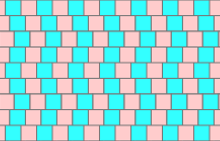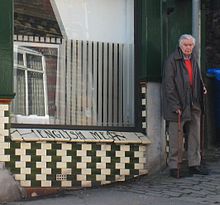

The café wall illusion (also known as the Münsterberg illusion or the kindergarten illusion) is a geometrical-optical illusion in which the parallel straight dividing lines between staggered rows with alternating dark and light rectangles (such as bricks or tiles) appear to be sloped, not parallel as they really are.
The phenomenon has been rediscovered several times. A version of the illusion was first described by Hugo Münsterberg in 1894, then described as the 'kindergarten illusion' in 1898 by A. H. Pierce, and under its current name in 1973 by Richard Gregory. According to Gregory, this effect was observed by a member of his laboratory, Steve Simpson, in the tiles of the wall of a café at the bottom of St Michael's Hill, Bristol.
In the construction of the illusion often each "brick" is surrounded by a layer of "mortar" intermediate between the dark and light colours of the "bricks".
In attempts at its deconstruction, the illusion was ascribed largely to the irradiation illusion (apparent greater size of a white area than of a black one), and the image disappears when black and white are replaced by different colours of the same brightness. But a component of the illusion remains even when all optical and retinal components are factored out. Contrast polarities seem to be the determining factor in the tilt's direction.


See also
References
- "Münsterberg illusion". Oxford Reference. Oxford University Press. Retrieved 15 May 2023.
- Day, Ross Henry (1978). "A note on the Münsterberg or café wall illusion". Perception. 7 (1): 123–124. doi:10.1068/p070123. Retrieved 15 May 2023.
- Münsterberg, Hugo (1894). Pseudoptics. New York: Milton Bradley.
- ^ Münsterberg, H. (1897). "Die verschobene Schachbrettfigur". Zeitschrift für Psychologie. 15: 184–88.
- Pierce, A. H. (1898). "The illusions of the kindergarten patterns" (PDF). Psychological Review. 5 (3): 233–53. doi:10.1037/h0070595.
- Gregory, R. L.; Heard, P. (1979). "Border locking and the Café Wall illusion" (PDF). Perception. 8 (4): 365–80. doi:10.1068/p080365. PMID 503767.
- Morgan, M. J.; Moulden, B. (1986). "The Münsterberg figure and twisted cords". Vision Research. 26 (11): 1793–1800. doi:10.1016/0042-6989(86)90130-6.
- Pierce, A. H. (1901). Studies in Auditory and Visual Space Perception. London: Longmans Green.
- Westheimer, G. (2007). "Irradiation, border location and the shifted-chessboard pattern". Perception. 36 (4): 483–94. doi:10.1068/p5646.
- Kitaoka, A; Pinna, B.; Brelstaff, G. (2004). "Contrast polarities determine the direction of Cafe Wall tilts" (PDF). Perception. 33 (1): 11–20. doi:10.1068/p3346. PMID 15035325.
External links
- An interactive version of the Café wall illusion that allows for adjusting the offset and turning the black boxes into white boxes
- An animated proof that the horizontal lines are parallel and straight
- The original café in Bristol on Google Maps Street View
| Optical illusions (list) | ||
|---|---|---|
| Illusions |
| |
| Popular culture |
| |
| Related | ||
This design-related article is a stub. You can help Misplaced Pages by expanding it. |